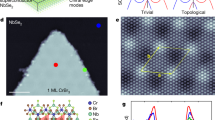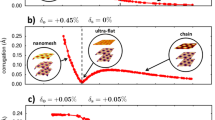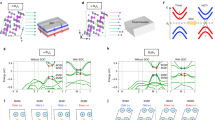Abstract
Superlattices—a periodic stacking of two-dimensional layers of two or more materials—provide a versatile scheme for engineering materials with tailored properties1,2. Here we report an intrinsic heterodimensional superlattice consisting of alternating layers of two-dimensional vanadium disulfide (VS2) and a one-dimensional vanadium sulfide (VS) chain array, deposited directly by chemical vapour deposition. This unique superlattice features an unconventional 1T stacking with a monoclinic unit cell of VS2/VS layers identified by scanning transmission electron microscopy. An unexpected Hall effect, persisting up to 380 kelvin, is observed when the magnetic field is in-plane, a condition under which the Hall effect usually vanishes. The observation of this effect is supported by theoretical calculations, and can be attributed to an unconventional anomalous Hall effect owing to an out-of-plane Berry curvature induced by an in-plane magnetic field, which is related to the one-dimensional VS chain. Our work expands the conventional understanding of superlattices and will stimulate the synthesis of more extraordinary superstructures.
This is a preview of subscription content, access via your institution
Access options
Access Nature and 54 other Nature Portfolio journals
Get Nature+, our best-value online-access subscription
$29.99 / 30 days
cancel any time
Subscribe to this journal
Receive 51 print issues and online access
$199.00 per year
only $3.90 per issue
Buy this article
- Purchase on Springer Link
- Instant access to full article PDF
Prices may be subject to local taxes which are calculated during checkout




Similar content being viewed by others
Data availability
Source data are provided with this paper.
Change history
13 October 2022
A Correction to this paper has been published: https://doi.org/10.1038/s41586-022-05430-5
References
Novoselov, K. S., Mishchenko, A., Carvalho, A. & Castro Neto, A. H. 2D materials and van der Waals heterostructures. Science 353, aac9439 (2016).
Esaki, L. & Chang, L. L. New transport phenomenon in a semiconductor “superlattice”. Phys. Rev. Lett. 33, 495–498 (1974).
Liu, Y. et al. Van der Waals heterostructures and devices. Nat. Rev. Mater. 1, 16042 (2016).
Björk, M. T. et al. One-dimensional steeplechase for electrons realized. Nano Lett. 2, 87–89 (2002).
Dumestre, F., Chaudret, B., Amiens, C., Renaud, P. & Fejes, P. Superlattices of iron nanocubes synthesized from Fe[N(SiMe3)2]2. Science 303, 821–823 (2004).
Ryu, Y. K., Frisenda, R. & Castellanos-Gomez, A. Superlattices based on van der Waals 2D materials. Chem. Commun. 55, 11498–11510 (2019).
Hu, M. & Poulikakos, D. Si/Ge superlattice nanowires with ultralow thermal conductivity. Nano Lett. 12, 5487–5494 (2012).
Davies, R. A., Kelly, M. J., Kerr, T. M., Hetherington, C. J. D. & Humphreys, C. J. Geometric and electronic structure of a semiconductor superlattice. Nature 317, 418–419 (1985).
Silbernagel, B. G., Levy, R. B. & Gamble, F. R. Magnetic properties of V5S8: an NMR study. Phys. Rev. B 11, 4563–4570 (1975).
Jariwala, D., Marks, T. J. & Hersam, M. C. Mixed-dimensional van der Waals heterostructures. Nat. Mater. 16, 170–181 (2017).
Yankowitz, M. et al. Emergence of superlattice Dirac points in graphene on hexagonal boron nitride. Nat. Phys. 8, 382–386 (2012).
Cao, Y. et al. Unconventional superconductivity in magic-angle graphene superlattices. Nature 556, 43–50 (2018).
Li, X.-B., Chen, N.-K., Wang, X.-P. & Sun, H.-B. Phase-change superlattice materials toward low power consumption and high density data storage: microscopic picture, working principles, and optimization. Adv. Funct. Mater. 28, 1803380 (2018).
Wang, C. et al. Monolayer atomic crystal molecular superlattices. Nature 555, 231–236 (2018).
Zhong, Y. et al. Wafer-scale synthesis of monolayer two-dimensional porphyrin polymers for hybrid superlattices. Science 366, 1379–1384 (2019).
Yang, J. et al. Ultrahigh-current-density niobium disulfide catalysts for hydrogen evolution. Nat. Mater. 18, 1309–1314 (2019).
Ji, Q. et al. Metallic vanadium disulfide nanosheets as a platform material for multifunctional electrode applications. Nano Lett. 17, 4908–4916 (2017).
Deng, Y. et al. Quantum anomalous Hall effect in intrinsic magnetic topological insulator MnBi2Te4. Science 367, 895–900 (2020).
Mitchson, G. et al. Structural changes in 2D BiSe bilayers as n increases in (BiSe)1+δ(NbSe2)n (n = 1–4) heterostructures. ACS Nano 10, 9489–9499 (2016).
Li, Z. et al. Molecule-confined engineering toward superconductivity and ferromagnetism in two-dimensional superlattice. J. Am. Chem. Soc. 139, 16398–16404 (2017).
Georgiou, T. et al. Vertical field-effect transistor based on graphene-WS2 heterostructures for flexible and transparent electronics. Nat. Nanotechnol. 8, 100–103 (2013).
Zhong, D. et al. Van der Waals engineering of ferromagnetic semiconductor heterostructures for spin and valleytronics. Sci. Adv. 3, e1603113 (2017).
Hou, Y., Kim, J. & Wu, R. Magnetizing topological surface states of Bi2Se3 with a CrI3 monolayer. Sci. Adv. 5, eaaw1874 (2019).
Geim, A. K. & Grigorieva, I. V. Van der Waals heterostructures. Nature 499, 419–425 (2013).
Haigh, S. J. et al. Cross-sectional imaging of individual layers and buried interfaces of graphene-based heterostructures and superlattices. Nat. Mater. 11, 764–767 (2012).
Chang, L. L. & Esaki, L. Semiconductor superlattices by MBE and their characterization. Prog. Cryst. Growth Charact. 2, 3–14 (1979).
Yao, J. et al. Optical transmission enhancement through chemically tuned two-dimensional bismuth chalcogenide nanoplates. Nat. Commun. 5, 5670 (2014).
Devarakonda, A. et al. Clean 2D superconductivity in a bulk van der Waals superlattice. Science 370, 231–236 (2020).
Zhou, J. et al. A library of atomically thin metal chalcogenides. Nature 556, 355–359 (2018).
Niu, J. et al. Anomalous Hall effect and magnetic orderings in nanothick V5S8. Phys. Rev. B 96, 075402 (2017).
Hardy, W. J. et al. Thickness-dependent and magnetic-field-driven suppression of antiferromagnetic order in thin V5S8 single crystals. ACS Nano 10, 5941–5946 (2016).
Li, S. et al. Vapour–liquid–solid growth of monolayer MoS2 nanoribbons. Nat. Mater. 17, 535–542 (2018).
Yuan, J. et al. Facile synthesis of single crystal vanadium disulfide nanosheets by chemical vapor deposition for efficient hydrogen evolution reaction. Adv. Mater. 27, 5605–5609 (2015).
Liang, S. et al. Experimental tests of the chiral anomaly magnetoresistance in the Dirac–Weyl semimetals Na3Bi and GdPtBi. Phys. Rev. X 8, 031002 (2018).
Wang, Y. et al. Antisymmetric linear magnetoresistance and the planar Hall effect. Nat. Commun 11, 216 (2020).
Jiang, B. et al. Chirality-dependent Hall effect and antisymmetric magnetoresistance in a magnetic Weyl semimetal. Phys. Rev. Lett. 126, 236601 (2021).
De Vries, A. B. & Haas, C. Magnetic susceptibility and nuclear magnetic resonance of vanadium sulfides. J. Phys. Chem. Solids 34, 651–659 (1973).
Nozaki, H., Ishizawa, Y., Saeki, M. & Nakahira, M. Electrical properties of V5S8 single crystals. Phys. Lett. A 54, 29–30 (1975).
Xiao, D., Chang, M.-C. & Niu, Q. Berry phase effects on electronic properties. Rev. Mod. Phys. 82, 1959–2007 (2010).
Liu, X., Hsu, H. C. & Liu, C. X. In-plane magnetization-induced quantum anomalous Hall effect. Phys. Rev. Lett. 111, 086802 (2013).
Fang, C., Gilbert, M. J. & Bernevig, B. A. Bulk topological invariants in noninteracting point group symmetric insulators. Phys. Rev. B 86, 115112 (2012).
Liu, Z. et al. Intrinsic quantum anomalous Hall effect with in-plane magnetization: searching rule and material prediction. Phys. Rev. Lett. 121, 246401 (2018).
Acknowledgements
The work was supported by: the National Key R&D Program of China (grant number 2020YFA0308800), the NSF of China (grant numbers 12074009, 11774009, 62174013, 12061131102 and 11734003), BIT (number 2021CX11013) and the National Key R&D Program of China (2017YFA0206301); the National Research Foundation, Singapore, under its Competitive Research Programme (NRF-CRP22-2019-0007 and NRF-CRP22-2019-0004), under its NRF-ISF joint research programme (NRF2020-NRF-ISF004-3520); and the Ministry of Education, Singapore, under its AcRF Tier 3 Programme ‘Geometrical Quantum Materials’ (MOE2018-T3-1-002). H.D., and W.G. acknowledge funding from the National Key Basic Research Program of China (2017YFB0701603) and NSFC (number 51971037). We thank X. Dai and H. M. Weng for discussions and their preliminary attempts on ab initio calculations. Y.-C.L. and K.S. acknowledge the JSPS-KAKENHI (JP16H06333 and JP22H05478), (18K14119), the JST-CREST programme (JPMJCR20B1, JMJCR20B5 and JPMJCR1993), the JSPS A3 Foresight Program, and the Kazato Research Encouragement Prize. Y.G. acknowledges funding from the Innovation Program of Shanghai Municipal Education Commission (number 2019-01-07-00-09-E00020), Shanghai Municipal Science and Technology Commission (18JC1412800). Jianhui Zhou was supported by the High Magnetic Field Laboratory of Anhui Province. Yugui Yao acknowledges the Strategic Priority Research Program of Chinese Academy of Sciences (grant number XDB30000000).
Author information
Authors and Affiliations
Contributions
Jiadong Zhou, W.Z., Y.-C.L. and J.C. contributed equally to this work. W.Z. and X.W. initiated the project and observed the novel Hall effect. Jiadong Zhou and Z.L. proposed the heterodimensional superlattice concept and coordinated the project. Jiadong Zhou and Y.Z. synthesized the superlattice and carried out the Raman and atomic force microscopy measurements. Y.Z. analysed the XPS data. Yuan Yao carried out preliminary STEM experiments. Y.-C.L. and K.S. performed the STEM and EELS measurements. W.Z., B.J. and X.W. carried out the device measurements. Yugui Yao, Y.W. and Y. Hou discussed the structure. Yugui Yao, X.W., Jianhui Zhou, J.C. and Jiadong Zhou discussed the theory calculation process. H.D., W.G. J.C., Jianhui Zhou, W.J. and Yugui Yao performed the theory calculation. J.C., Jianhui Zhou, W.J. and Yugui Yao performed the calculations. X.C. and Y. Huang helped to perform the FIB. J.S. performed the SHG measurements. W.Z. and S.S.P.P. performed the MOKE measurement. B.T., B.L., Q.F. and C.Z. discussed the SHG. All authors contributed to the discussion of the results.
Corresponding authors
Ethics declarations
Competing interests
The authors declare no competing interests.
Peer review
Peer review information
Nature thanks Kai Xiao and the other, anonymous, reviewer(s) for their contribution to the peer review of this work.
Additional information
Publisher’s note Springer Nature remains neutral with regard to jurisdictional claims in published maps and institutional affiliations.
Supplementary information
Supplementary Information
This file contains Supplementary Figs. 1–31, Tables 1–4 and References.
Rights and permissions
Springer Nature or its licensor (e.g. a society or other partner) holds exclusive rights to this article under a publishing agreement with the author(s) or other rightsholder(s); author self-archiving of the accepted manuscript version of this article is solely governed by the terms of such publishing agreement and applicable law.
About this article
Cite this article
Zhou, J., Zhang, W., Lin, YC. et al. Heterodimensional superlattice with in-plane anomalous Hall effect. Nature 609, 46–51 (2022). https://doi.org/10.1038/s41586-022-05031-2
Received:
Accepted:
Published:
Issue Date:
DOI: https://doi.org/10.1038/s41586-022-05031-2
This article is cited by
-
Observation of giant room-temperature anisotropic magnetoresistance in the topological insulator β-Ag2Te
Nature Communications (2024)
-
Functional nanoporous graphene superlattice
Nature Communications (2024)
-
Heterodimensional hybrids assembled with multiple-dimensional copper selenide hollow microspheres and graphene oxide nanosheets for electromagnetic energy conversion and electrochemical energy storage
Advanced Composites and Hybrid Materials (2024)
-
Vapour-phase deposition of two-dimensional layered chalcogenides
Nature Reviews Materials (2023)
-
Ultrafast charge transfer in mixed-dimensional WO3-x nanowire/WSe2 heterostructures for attomolar-level molecular sensing
Nature Communications (2023)
Comments
By submitting a comment you agree to abide by our Terms and Community Guidelines. If you find something abusive or that does not comply with our terms or guidelines please flag it as inappropriate.



